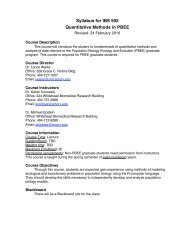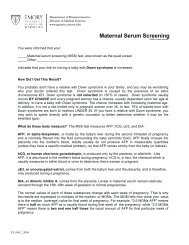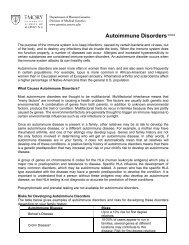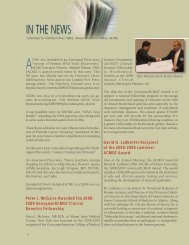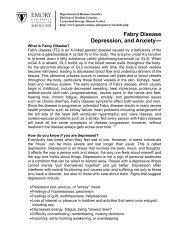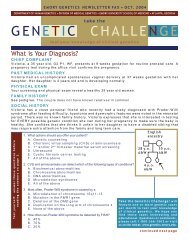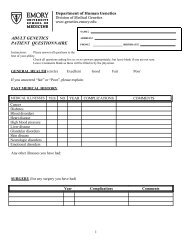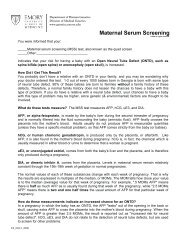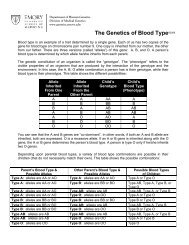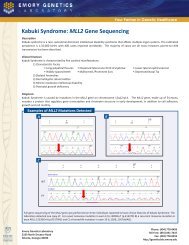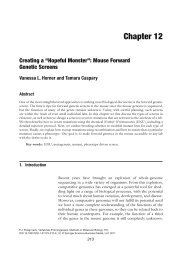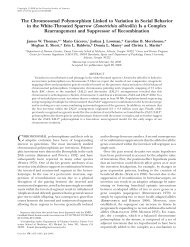Genetic Variation in Rates of Nondisjunction: Association ... - Genetics
Genetic Variation in Rates of Nondisjunction: Association ... - Genetics
Genetic Variation in Rates of Nondisjunction: Association ... - Genetics
You also want an ePaper? Increase the reach of your titles
YUMPU automatically turns print PDFs into web optimized ePapers that Google loves.
Copyright © 1999 by the <strong>Genetic</strong>s Society <strong>of</strong> America<br />
<strong>Genetic</strong> <strong>Variation</strong> <strong>in</strong> <strong>Rates</strong> <strong>of</strong> <strong>Nondisjunction</strong>: <strong>Association</strong> <strong>of</strong> Two Naturally<br />
Occurr<strong>in</strong>g Polymorphisms <strong>in</strong> the Chromok<strong>in</strong>es<strong>in</strong> nod With Increased<br />
<strong>Rates</strong> <strong>of</strong> <strong>Nondisjunction</strong> <strong>in</strong> Drosophila melanogaster<br />
Michael E. Zwick, Jennifer L. Salstrom and Charles H. Langley<br />
Center for Population Biology, University <strong>of</strong> California, Davis, California 95616<br />
Manuscript received December 4, 1998<br />
Accepted for publication April 9, 1999<br />
ABSTRACT<br />
<strong>Genetic</strong> variation <strong>in</strong> nondisjunction frequency among X chromosomes from two Drosophila melanogaster<br />
natural populations is exam<strong>in</strong>ed <strong>in</strong> a sensitized assay. A high level <strong>of</strong> genetic variation is observed (a range<br />
<strong>of</strong> 0.006–0.241). Two naturally occurr<strong>in</strong>g variants at the nod locus, a chromok<strong>in</strong>es<strong>in</strong> required for proper<br />
achiasmate chromosome segregation, are significantly associated with an <strong>in</strong>creased frequency <strong>of</strong> nondisjunction.<br />
Both <strong>of</strong> these polymorphisms are found at <strong>in</strong>termediate frequency <strong>in</strong> widely distributed natural<br />
populations. To account for these observations, we propose a general model <strong>in</strong>corporat<strong>in</strong>g unique opportunities<br />
for meiotic drive dur<strong>in</strong>g female meiosis. The oötid competition model can account for both high<br />
mean rates <strong>of</strong> female-specific nondisjunction <strong>in</strong> Drosophila and humans as well as the stand<strong>in</strong>g genetic<br />
variation <strong>in</strong> this critical fitness character <strong>in</strong> natural populations.<br />
IN the 83 years s<strong>in</strong>ce Calv<strong>in</strong> Bridges (1916) employed<br />
nondisjunction to <strong>in</strong>terpret the outcome <strong>of</strong><br />
I? Second, what can account for the high frequency<br />
<strong>of</strong> spontaneous nondisjunction <strong>in</strong> both Drosophila<br />
experiments that ultimately provided the foundation (Bridges 1916; Merriam and Frost 1964; Koehler et<br />
for the chromosome theory <strong>of</strong> <strong>in</strong>heritance, significant al. 1996a) and human females (Hassold et al. 1996)?<br />
advances have been made <strong>in</strong> understand<strong>in</strong>g the genetic Two dist<strong>in</strong>ct game theory models constitute the only<br />
events lead<strong>in</strong>g to the failure <strong>of</strong> chromosome segregation evolutionary analyses that attempt to expla<strong>in</strong> the ob-<br />
<strong>in</strong> Drosophila melanogaster (see Hawley et al. 1992 for a served patterns <strong>of</strong> spontaneous nondisjunction (Axel-<br />
review). Recent studies suggest that the genetic events rod and Hamilton 1981; Day and Taylor 1998). Close<br />
underly<strong>in</strong>g nondisjunction appear remarkably similar exam<strong>in</strong>ation <strong>of</strong> both models leads to their rejection<br />
<strong>in</strong> Drosophila and humans (Koehler et al. 1996a,b; for a variety <strong>of</strong> reasons. First, Axelrod and Hamilton<br />
Lamb et al. 1996; Bugge et al. 1998; Rob<strong>in</strong>son et al. (1981) propose an unrealistic iterated prisoner di-<br />
1998). Spontaneous nondisjunction <strong>in</strong> both Drosophila lemma (IPD) model that is rejected by a theoretical<br />
and humans is characterized by three dist<strong>in</strong>ct proper- analysis <strong>in</strong> Day and Taylor (1998). But the Day and<br />
ties: the vast majority <strong>of</strong> events occur <strong>in</strong> females at meio- Taylor (1998) chromosome drive (CD) model also<br />
sis I, nondisjunctional chromosomes exhibit reduced conta<strong>in</strong>s a critical flaw. Its one unique prediction, that<br />
levels and abnormal distributions <strong>of</strong> cross<strong>in</strong>g-over, and all nondisjunction must result <strong>in</strong> trisomy (diplo excep-<br />
rates <strong>of</strong> nondisjunction <strong>in</strong>crease with maternal age (Pen- tions) rather than nullosomies (nullo exceptions), is<br />
rose 1933; Merriam and Frost 1964; Tokunaga clearly not consistent with the observed data from either<br />
1970a,b; Carpenter 1973; Warren et al. 1987; Sherman Drosophila or humans (Bridges 1916; Sturtevant<br />
et al. 1991, 1994; Koehler et al. 1996a,b; Lamb et al. and Beadle 1936; Merriam and Frost 1964; Koehler<br />
1996, 1997; Bugge et al. 1998; Rob<strong>in</strong>son et al. 1998). et al. 1996a; human data reviewed <strong>in</strong> Hassold et al.<br />
Despite progress <strong>in</strong> elucidat<strong>in</strong>g the proximate causes <strong>of</strong> 1996). Thus neither evolutionary model provides an<br />
nondisjunction, the evolutionary basis for the observed adequate explanation for the observed patterns <strong>of</strong> spon-<br />
pattern and prevalence <strong>of</strong> spontaneous nondisjunction taneous nondisjunction.<br />
rema<strong>in</strong>s largely unknown.<br />
One possible explanation for the observed sex bias <strong>in</strong><br />
Two aspects <strong>of</strong> spontaneous nondisjunction appear rates <strong>of</strong> nondisjunction is that natural populations do<br />
particularly paradoxical. First, why does spontaneous not harbor any genetic variation <strong>in</strong> rates <strong>of</strong> female-spenondisjunction<br />
display a sex bias, with the vast majority cific nondisjunction. As a consequence, natural selec-<br />
<strong>of</strong> segregation errors occurr<strong>in</strong>g <strong>in</strong> females at meiosis tion could not act to <strong>in</strong>crease the fidelity <strong>of</strong> chromosome<br />
transmission dur<strong>in</strong>g female meiosis. Numerous previous<br />
studies have detected genetic variation for recomb<strong>in</strong>a-<br />
Correspond<strong>in</strong>g author: Michael E. Zwick, Department <strong>of</strong> <strong>Genetic</strong>s,<br />
Case Western Reserve University, 10900 Euclid Ave., Cleveland, OH<br />
44106-4955. E-mail: mez4@po.cwru.edu<br />
tion rates <strong>in</strong> female meiosis (reviewed <strong>in</strong> Brooks 1988).<br />
Some Drosophila stocks harbor genetic variation <strong>in</strong> recomb<strong>in</strong>ation<br />
rates as evidenced by their response to<br />
<strong>Genetic</strong>s 152: 1605–1614 (August 1999)
1606 M. E. Zwick, J. L. Salstrom and C. H. Langley<br />
artificial selection (Roberts and Roberts 1921; Par- to account for the elevated mean rates <strong>of</strong> female-specific<br />
sons 1958; Kidwell 1972a,b; Charlesworth and nondisjunction <strong>in</strong> both Drosophila and humans and for<br />
Charlesworth 1985a,b). D. melanogaster and D. pseudo- the large level <strong>of</strong> genetic variation <strong>in</strong> this critical fitness<br />
obscura both exhibit variation <strong>in</strong> rates <strong>of</strong> recomb<strong>in</strong>ation<br />
among stocks derived from natural populations (Lev<strong>in</strong>e<br />
and Lev<strong>in</strong>e 1954a,b; Lawrence 1958, 1963; Green<br />
character with<strong>in</strong> D. melanogaster natural populations.<br />
1959). Artificial selection to <strong>in</strong>crease the rate <strong>of</strong> recom-<br />
MATERIALS AND METHODS<br />
b<strong>in</strong>ation on an autosome has been shown to concomitantly<br />
decrease rates <strong>of</strong> X chromosome nondisjunction<br />
(Charlesworth et al. 1985). And while variation <strong>in</strong><br />
Drosophila l<strong>in</strong>es: Drosophila melanogaster isogenic X chromo-<br />
some l<strong>in</strong>es were sampled at random from natural populations<br />
<strong>in</strong> North America and Africa. North American l<strong>in</strong>es were<br />
rates <strong>of</strong> nondisjunction has been detected <strong>in</strong> Drosophila collected from Raleigh, North Carol<strong>in</strong>a as described <strong>in</strong> Miyalaboratory<br />
stocks (Bridges 1916; Merriam and Frost<br />
1964; Koehler et al. 1996a), with the exception <strong>of</strong> a<br />
s<strong>in</strong>gle study designed to detect and isolate large-effect<br />
meiotic mutants from natural populations (Sandler et<br />
shita et al. (1993). African l<strong>in</strong>es were collected from Zim-<br />
babwe as described <strong>in</strong> Begun and Aquadro (1993). All balancers<br />
and marker stocks are as described <strong>in</strong> L<strong>in</strong>dsley and Zimm<br />
(1992). To m<strong>in</strong>imize the effects <strong>of</strong> the autosomes on X chro-<br />
mosome nondisjunction, an autosomal isogenic background<br />
al. 1968), the existence <strong>of</strong> naturally occurr<strong>in</strong>g genetic was constructed by employ<strong>in</strong>g a stock whose genotype was<br />
T(2;3)CyOTM6/; mwh ry506 e1 ; spapol (hereafter, spapol variation <strong>in</strong> rates <strong>of</strong> spontaneous nondisjunction re-<br />
ma<strong>in</strong>s largely unknown.<br />
Because spontaneous nondisjunction occurs at a frequency<br />
that makes it difficult to measure <strong>in</strong> a reasonably<br />
will be<br />
referred to as pol). This allowed the simultaneous isolation<br />
<strong>of</strong> a s<strong>in</strong>gle second (marked with b) and third chromosome<br />
(marked with ri) that were subsequently backcrossed and<br />
made homozygous. The result<strong>in</strong>g genotype <strong>of</strong> the common<br />
sized experiment, direct estimation <strong>of</strong> variation among<br />
a large number <strong>of</strong> different genotypes <strong>in</strong> their rates <strong>of</strong><br />
nondisjunction is laborious. To overcome this impedi-<br />
ment, we employ an alternative strategy to detect naturally<br />
occurr<strong>in</strong>g variation <strong>in</strong> rates <strong>of</strong> nondisjunction. The<br />
isogenic background was b; ri; pol. Each experimental Xi chro-<br />
mosome (where i refers to the ith X chromosome from either<br />
North America or Africa), the balancer FM7a, and an X chromosome<br />
conta<strong>in</strong><strong>in</strong>g the markers ycvvfcarwere substituted<br />
<strong>in</strong>to this common genetic background.<br />
Experimental crosses: Experimental females were generated<br />
by cross<strong>in</strong>g FM7a, y sc 8 w a v nod4 B/y most frequent nondisjunction event <strong>in</strong> D. melanogaster<br />
<strong>in</strong>volves the X chromosome result<strong>in</strong>g <strong>in</strong> diplo (2X) and<br />
Y; pol males to Xi; b; ri; pol virg<strong>in</strong> females. Virg<strong>in</strong> females whose genotype was<br />
FM7a, y sc 8 w a v nod4 nullo (0X) exceptions. Three-quarters <strong>of</strong> X chromo-<br />
some nondisjunction arises from noncrossover chromo-<br />
B/Xi;b/; ri/; pol were aged <strong>in</strong> vials<br />
for 2 days. An experimental cross consisted <strong>of</strong> cross<strong>in</strong>g 30 y<br />
v/yY; C(4)RM, ci eyR somes that normally segregate via the homologous achimales<br />
to an equal number <strong>of</strong> FM7a, y<br />
sc 8 w a v nod4 B/Xi;b/; ri/; spapol asmate pathway (Hawley et al. 1992; Koehler et al.<br />
1996a). Because most nondisjunction arises from the<br />
failure <strong>of</strong> the homologous achiasmate system, we de-<br />
vised a sensitized assay to measure transmission efficiency<br />
<strong>in</strong> this pathway among a set <strong>of</strong> X chromosomes<br />
2-day-old virg<strong>in</strong> females<br />
<strong>in</strong> bottles conta<strong>in</strong><strong>in</strong>g fresh glucose media (Figure 1). Each<br />
experimental cross was brooded, with the orig<strong>in</strong>al parents<br />
transferred to new bottles on days 4 and 8. For any experimental<br />
cross, the first bottle was brood 1, the day 4 bottle was<br />
brood 2, and the day 8 bottle was brood 3. All experimental<br />
crosses were ma<strong>in</strong>ta<strong>in</strong>ed <strong>in</strong> an <strong>in</strong>cubator at 24 with a 12-hr<br />
sampled at random from natural populations <strong>in</strong> North dark/light cycle. For all broods with<strong>in</strong> each experimental<br />
America and Africa. Sensitized assays are exploited by<br />
many genetic enhancer/suppressor screens and also<br />
have been employed <strong>in</strong> evolutionary studies to detect<br />
activity differences among electrophoretic variants<br />
cross, all progeny were scored for their phenotypic markers<br />
(see Figure 1) on days 11 through 18, after which the bottles<br />
were discarded. X-chromosome nondisjunction was observed<br />
by the recovery <strong>of</strong> diplo X females (FM7/Xi) and nullo X males<br />
(y v/O). One-half <strong>of</strong> nondisjunctional classes are lethal (XXX<br />
(Labate and Eanes 1992). and O/O), so the frequency <strong>of</strong> X chromosome nondisjunction<br />
We report the results <strong>of</strong> a sensitized assay that demon- was calculated as (2 Observed Diplo Nullo Exceptions)/<br />
strates 10-fold differences among X chromosomes <strong>in</strong><br />
their rates <strong>of</strong> nondisjunction <strong>in</strong> the homologous achias-<br />
(Total Progeny Diplo Exceptions Nullo Exceptions). We<br />
also simultaneously measured rates <strong>of</strong> fourth chromosome<br />
nondisjunction by recover<strong>in</strong>g C(4)RM, ci eyR mate system. We further identify two naturally occurr<strong>in</strong>g<br />
variants at the nod locus, a chromok<strong>in</strong>es<strong>in</strong> required for<br />
nullo exceptions<br />
and pol diplo exceptions <strong>in</strong> both sexes. One-half <strong>of</strong> both the<br />
regular and nondisjunctional classes are M<strong>in</strong>ute or lethal.<br />
proper achiasmate chromosome segregation (Baker Therefore, the rates <strong>of</strong> fourth chromosome nondisjunction<br />
and Carpenter 1972; Carpenter 1973; Zhang and<br />
Hawley 1990; Zhang et al. 1990; Afshar et al. 1995a,b),<br />
that are significantly associated with an <strong>in</strong>creased frequency<br />
<strong>of</strong> nondisjunction. Both polymorphisms are<br />
are simply calculated as the (Observed 4th Exceptions)/(Total<br />
progeny). Fourth chromosomes do not undergo meiotic recomb<strong>in</strong>ation<br />
and depend upon the homologous achiasmate<br />
system to ensure their proper segregation. Total sample sizes<br />
were 98,184 for North America and 103,921 for Africa.<br />
widely distributed and at <strong>in</strong>termediate frequency <strong>in</strong> nat- The experimental cross was sensitized <strong>in</strong> three ways by the<br />
addition <strong>of</strong> the FM7 balancer conta<strong>in</strong><strong>in</strong>g the nod4 ural populations. The observation <strong>of</strong> substantial genetic<br />
variation <strong>in</strong> rates <strong>of</strong> nondisjunction is consistent with<br />
the variation <strong>in</strong> E0 tetrad frequency described <strong>in</strong> a companion<br />
article (Zwick et al. 1999, this issue). We propose<br />
null allele.<br />
First, FM7 is a strong suppressor <strong>of</strong> exchange that forces all<br />
X chromosomes to segregate via the homologous achiasmate<br />
system (Hawley et al. 1992). Second, alleles at other meiotic<br />
loci can act as dom<strong>in</strong>ant enhancers <strong>of</strong> nod4 <strong>in</strong> nod4 / het-<br />
a general model, the oötid competition (OC) model,<br />
erozygotes (Knowles and Hawley 1991). Third, naturally
<strong>Genetic</strong> <strong>Variation</strong> <strong>in</strong> <strong>Nondisjunction</strong><br />
1607<br />
DNA sequenc<strong>in</strong>g <strong>of</strong> PCR products was accomplished with <strong>in</strong>ternal<br />
primers (5-GAAACGTGAAACCTGCGC-3 and 5-CGG<br />
CGCAGCACGCGGCTGGC-3) <strong>in</strong> an ABI Prism 377 (Perk<strong>in</strong><br />
Elmer, Norwalk, CT).<br />
For the geographic survey, PCR products were digested for<br />
1hrat65 with TaqI restriction endonuclease. The result<strong>in</strong>g<br />
fragments were run on a 1.5% agarose gel, sta<strong>in</strong>ed with ethidium<br />
bromide, photographed, and scored. Alleles with the nod <br />
GenBank reference sequence conta<strong>in</strong> a TaqI site at nucleotide<br />
position 4515, while those with the nod 9 -like haplotype lack<br />
this TaqI site. As a consequence, a TaqI restriction digest <strong>of</strong><br />
a nod haplotype results <strong>in</strong> five fragments (sizes: 289, 266,<br />
150, 78, 40, 28 bp), while a similar digest <strong>of</strong> a nod 9 haplotype<br />
results <strong>in</strong> five fragments (sizes: 344, 289, 150, 40, 28 bp). The<br />
two haplotypes are easily differentiated by the presence <strong>of</strong> the<br />
344-bp or 266-bp fragments.<br />
Statistical analysis: To test for possible associations between<br />
genetic markers and frequency <strong>of</strong> nondisjunction, we employed<br />
a permutation test<strong>in</strong>g approach (Churchill and<br />
Doerge 1994; Long et al. 1998). Mean frequencies <strong>of</strong> nondisjunction<br />
for each l<strong>in</strong>e were log 10 transformed to make the<br />
variance <strong>in</strong>dependent <strong>of</strong> the mean. To test for differences<br />
between the means <strong>of</strong> the two populations or among genetic<br />
variants with<strong>in</strong> a s<strong>in</strong>gle population, the test statistic<br />
t 1 2 √s2 1 s2 (1)<br />
2<br />
was employed, where 1 and 2 are the means <strong>of</strong> two partitions<br />
<strong>of</strong> the dataset and s2 1 and s2 2 are the sample variances for the<br />
same partition. The permutation test consists <strong>of</strong> random resampl<strong>in</strong>g<br />
without replacement <strong>of</strong> the observed mean log-transformed<br />
frequencies to generate two new subsamples identical<br />
Figure 1.—Sensitized cross employed to assess variation <strong>in</strong><br />
<strong>in</strong> size to the orig<strong>in</strong>al sample, calculat<strong>in</strong>g the test statistic, and<br />
rates <strong>of</strong> X and 4 nondisjunction. Each genotypic class results<br />
stor<strong>in</strong>g the value. This operation was repeated 100,000 times<br />
<strong>in</strong> a different phenotype, so it is possible to simultaneously<br />
to determ<strong>in</strong>e the distribution <strong>of</strong> the test statistic. Significance<br />
score all progeny for their X and 4 genotypes.<br />
was assessed by determ<strong>in</strong><strong>in</strong>g the proportion <strong>of</strong> simulated test<br />
statistics exceed<strong>in</strong>g the observed test statistic us<strong>in</strong>g both tails<br />
<strong>of</strong> the simulated distribution. To test for different <strong>in</strong>teractions<br />
between the nod and nod9 haplotypes <strong>in</strong> dist<strong>in</strong>ct geographic<br />
occurr<strong>in</strong>g DNA sequence variation <strong>in</strong> centromeric and extra- regions, the test statistic<br />
centromeric regions is expected to measurably <strong>in</strong>fluence the<br />
fidelity <strong>of</strong> chromosome transmission dur<strong>in</strong>g female meiosis t ((A1 A2) (N1 N2)) √s2 A1 s2 A2 s2 N1 s2 (2)<br />
<strong>in</strong> nod N2<br />
4 / heterozygotes (Murphy and Karpen 1995). Dur<strong>in</strong>g<br />
the generation <strong>of</strong> experimental females, nondisjunction <strong>in</strong><br />
was employed, where A1 and A2 males could lead to females whose genotype would be FM7/<br />
are the means <strong>of</strong> the two<br />
partitions <strong>in</strong> the African population, N1 and N2 X<br />
are the means<br />
i/yY. <strong>Nondisjunction</strong> <strong>in</strong> these females will approach 60%,<br />
result<strong>in</strong>g <strong>in</strong> an excess <strong>of</strong> diplo X exceptions and yY sons.<br />
<strong>of</strong> the same two partitions <strong>in</strong> the North American population,<br />
and s2 A1, s2 A2, s2 N1, s2 Any l<strong>in</strong>es that produced more than two yv/yY males were<br />
N2, are the sample variances <strong>of</strong> the partitions<br />
discarded and assumed to have been contam<strong>in</strong>ated dur<strong>in</strong>g the<br />
with<strong>in</strong> each geographic location. This analysis was conducted<br />
generation <strong>of</strong> experimental females. There was no association<br />
<strong>in</strong> a similar permutation test framework. All statistical analyses<br />
between rates <strong>of</strong> nondisjunction measures and replicates <strong>of</strong><br />
were also performed on the raw and arc-s<strong>in</strong>-transformed fre-<br />
l<strong>in</strong>es discarded due to yY contam<strong>in</strong>ation (P 0.65). All high<br />
quencies, giv<strong>in</strong>g similar results. ANOVA to test for differences<br />
nondisjunction rate l<strong>in</strong>es showed an excess <strong>of</strong> nullo excep-<br />
<strong>in</strong> brood means and nonparametric Mann-Whitney U-tests<br />
tions. To ensure that no unmarked Y chromosome was preswere<br />
conducted with JMP 3.2.1 (SAS Institute).<br />
ent, a subset <strong>of</strong> yv/O males were tested for fertility by mat<strong>in</strong>g<br />
to multiple females <strong>in</strong> vials. No fertile males were detected<br />
(data not shown), suggest<strong>in</strong>g that no unmarked Y chromo-<br />
RESULTS<br />
somes were present <strong>in</strong> any <strong>of</strong> our stocks.<br />
<strong>Genetic</strong> variation <strong>in</strong> D. melanogaster nondisjunction<br />
Molecular analysis: Genomic DNA was prepared from 100<br />
flies from each isogenic X chromosome stock us<strong>in</strong>g an SDS rates: A surpris<strong>in</strong>gly high level <strong>of</strong> genetic variation <strong>in</strong><br />
lysis, organic extraction, ethanol precipitation protocol (Jow- rates <strong>of</strong> nondisjunction is observed among randomly<br />
ett 1986). PCR was conducted under standard conditions sampled X chromosomes from North America and Af-<br />
(50-l reaction volume: 2.5 l <strong>of</strong> two 10-m primers, 5 l <strong>of</strong> rica (Figure 2). With average sample sizes <strong>of</strong> 3400 flies<br />
10 buffer with MgCl, 2 l <strong>of</strong> dNTP (0.2 mm each dNTP),<br />
per X chromosome, the largest standard error <strong>of</strong> the<br />
36 l distilled water, 1 l Taq polymerase, 1 l DNA sample).<br />
The follow<strong>in</strong>g two unique primers from the nod locus genomic mean frequency <strong>of</strong> nondisjunction for any X chromosome<br />
is 5.9 103 sequence were employed: 5-GCGCTTATTTAATAGGTAGT<br />
. No effect <strong>of</strong> brood on the mean<br />
CTAAG-3 and 5-GCCCACAACTGTACGCTGCCAGCTG-3. frequency <strong>of</strong> nondisjunction is detected (P 0.38). The
1608 M. E. Zwick, J. L. Salstrom and C. H. Langley<br />
Figure 2.—Histogram show<strong>in</strong>g number <strong>of</strong> chromosomes<br />
Figure 4.—The nod transcript and the location <strong>of</strong> polymorwith<br />
different frequencies <strong>of</strong> nondisjunction <strong>in</strong> our sensitized<br />
phic regions are shown. The nod9 haplotype apparently arose<br />
assay. The randomly sampled African (A) and North American<br />
from a gene conversion event from either <strong>of</strong> two downstream<br />
(N) chromosomes are identified by an A and N, respectively,<br />
(non-nod) exons, which share 95% sequence identity with the<br />
above each column. The number <strong>of</strong> chromosomes conta<strong>in</strong><strong>in</strong>g<br />
3 portion <strong>of</strong> the nod transcript (Rasooly et al. 1994). DNA<br />
the nod (white), nod9 (black), or nodA4579T (gray) haplotypes<br />
sequence <strong>of</strong> nod and nod9 haplotypes shows the location <strong>of</strong><br />
and their observed frequency <strong>of</strong> nondisjunction are shown.<br />
four nucleotide differences, three <strong>of</strong> which result <strong>in</strong> am<strong>in</strong>o<br />
acid polymorphism. The upper am<strong>in</strong>o acids are coded for by<br />
the nod reference sequence. The first three lower am<strong>in</strong>o<br />
variation that we observe cannot be attributed to zygotic acids are coded for by the nod9 sequence. The last lower am<strong>in</strong>o<br />
acid is coded for by the nodA4579T sequence. The nodA4579T viability for two reasons. First, the nullo exception class is<br />
se-<br />
quence differs from nod genotypically identical <strong>in</strong> the assays <strong>of</strong> all X chromosome<br />
at nucleotide site 4579 and is found<br />
l<strong>in</strong>es. Second, if zygotic viability were significantly <strong>in</strong>flu- on three chromosomes <strong>in</strong> the North American sample and a<br />
s<strong>in</strong>gle chromosome from the African sample. Other rare and<br />
enc<strong>in</strong>g our results, we would not expect the high correlasilent<br />
nucleotide variants with<strong>in</strong> the 450 bp sequenced are<br />
tion between rates <strong>of</strong> X and 4 nondisjunction that we not shown <strong>in</strong> the figure.<br />
observe (Figure 3). Because our experimental design<br />
consisted <strong>of</strong> substitut<strong>in</strong>g each <strong>of</strong> the Xi chromosomes<br />
<strong>in</strong>to a common autosomal isogenic background, the nod locus, a chromok<strong>in</strong>es<strong>in</strong> required for proper achiasgenetic<br />
causes <strong>of</strong> the variation we observe must reside mate chromosome segregation (Baker and Carpenter<br />
on the <strong>in</strong>dividual X chromosomes. 1972; Carpenter 1973; Zhang and Hawley 1990;<br />
Identification and characterization <strong>of</strong> a candidate lo- Zhang et al. 1990; Rasooly et al. 1991; Afshar et al.<br />
cus: Naturally occurr<strong>in</strong>g variants at X-l<strong>in</strong>ked loci that 1995a,b). A candidate allele, nod9 , was found <strong>in</strong> a laborafunction<br />
<strong>in</strong> meiosis are a plausible source <strong>of</strong> genetic tory stock (Rasooly et al. 1994) employed <strong>in</strong> one <strong>of</strong> the<br />
variation <strong>in</strong> our experiment. One such candidate is the first large EMS screens for meiotic mutants (Baker and<br />
Carpenter 1972). This screen was highly successful <strong>in</strong><br />
that it recovered an extraord<strong>in</strong>ary number <strong>of</strong> newly <strong>in</strong>duced<br />
meiotic mutants, some <strong>of</strong> which were quite weak<br />
and were not recovered <strong>in</strong> later screens. Subsequent<br />
analysis <strong>of</strong> a laboratory stock conta<strong>in</strong><strong>in</strong>g a descendant<br />
copy <strong>of</strong> the X chromosome mutagenized by Baker and<br />
Carpenter (1972) yielded elevated rates <strong>of</strong> female-specific<br />
nondisjunction (Rasooly et al. 1994). Rasooly et<br />
al. (1994) identified a variant nucleotide sequence <strong>in</strong><br />
the 3 DNA b<strong>in</strong>d<strong>in</strong>g doma<strong>in</strong> (nod9 ) that they characterized<br />
as a “weak nod mutation.” They suggested that the<br />
recovery <strong>of</strong> weak meiotic mutants reported <strong>in</strong> Baker<br />
and Carpenter (1972) is best expla<strong>in</strong>ed if one assumes<br />
that the orig<strong>in</strong>al EMS screen was carried out <strong>in</strong> a “sensitized”<br />
background caused by the presence <strong>of</strong> the nod9 allele.<br />
The nod GenBank reference sequence and the nod9 haplotype differ at four nucleotide sites, three <strong>of</strong> which<br />
Figure 3.—Graph show<strong>in</strong>g the correlation <strong>of</strong> log-trans-<br />
result <strong>in</strong> am<strong>in</strong>o acid changes (Figure 4). A DNA seformed<br />
mean frequencies <strong>of</strong> X and 4 nondisjunction (R quence survey <strong>of</strong> North American and African X chro-<br />
2 <br />
0.86; P 1 104 ). mosomes <strong>in</strong> our sample demonstrates that the nod locus
<strong>Genetic</strong> <strong>Variation</strong> <strong>in</strong> <strong>Nondisjunction</strong><br />
The nodA4579T variant is marg<strong>in</strong>ally associated with an<br />
<strong>in</strong>creased frequency <strong>of</strong> nondisjunction <strong>in</strong> the North Carol<strong>in</strong>a<br />
sample (permutation, P 0.08; Mann-Whitney<br />
U-test, P 0.07). Because the nodA4579T variant is found<br />
only once <strong>in</strong> the African sample, it is not possible to<br />
carry out the permutation test while the nonparametric<br />
Mann-Whitney U-test is not significant (Mann-Whitney<br />
U-test, P 0.15). Because the mean frequency <strong>of</strong> nondisjunction<br />
did not differ between the samples from the<br />
two natural populations, it seemed reasonable to perform<br />
the permutation test on the total dataset to test<br />
the association <strong>of</strong> the nodA4579T polymorphism with nondisjunction<br />
frequency. The permutation test (P 0.02)<br />
and a nonparametric Mann-Whitney U-test (P 0.02)<br />
both showed that the nodA4579T polymorphism is significantly<br />
associated with an <strong>in</strong>creased frequency <strong>of</strong> nondisjunction<br />
(Figure 2). Further evidence for the association<br />
<strong>of</strong> both nod haplotypes with elevated rates <strong>of</strong> nondisjunction<br />
comes from the DNA sequenc<strong>in</strong>g <strong>of</strong> two <strong>in</strong>depen-<br />
Figure 5.—The mean rates <strong>of</strong> nondisjunction for each gedently<br />
derived nod alleles from X chromosome laboranotype/location<br />
comb<strong>in</strong>ation. The genotype column labels<br />
refer to the nod tory stocks that exhibit an elevated frequency <strong>of</strong><br />
and nod9 DNA sequences shown <strong>in</strong> Figure<br />
2. Marg<strong>in</strong>al column and row frequencies are located outside nondisjunction <strong>in</strong> an unsensitized background (R. S.<br />
the box. Numbers <strong>in</strong> parentheses are the numbers <strong>of</strong> X chro- Hawley, personal communication). One X chromomosomes<br />
<strong>in</strong> each category. some stock’s sequence is identical to that observed for<br />
the nod9 haplotype while the other conta<strong>in</strong>s the nodA4579 haplotype. These observations, <strong>in</strong> conjunction with<br />
is highly polymorphic for two haplotypes <strong>in</strong> the small<br />
those <strong>in</strong> Rasooly et al. (1994), lead us to surmise that<br />
region that dist<strong>in</strong>guishes nod from nod9 (Figures 4 and<br />
the variation we detected <strong>in</strong> our sensitized assay reliably<br />
5). Alleles with the typical nod sequence conta<strong>in</strong> a TaqI<br />
reflects variation present <strong>in</strong> natural populations. Howsite<br />
at nucleotide position 4515, while those with the<br />
ever, the absolute magnitude <strong>of</strong> nondisjunction attributnod9-like<br />
haplotype lack this TaqI site (TaqI , Figure 4).<br />
able to specific nod haplotypes or rates <strong>of</strong> spontaneous<br />
A PCR-based RFLP screen shows that the TaqI haplo-<br />
X chromosome nondisjunction cannot be determ<strong>in</strong>ed<br />
type is also found at <strong>in</strong>termediate frequency <strong>in</strong> populaby<br />
our assay.<br />
tions from Barcelona, Spa<strong>in</strong> (0.44, N 27) and Davis,<br />
We propose the OC model to account for both the<br />
California (0.48, N 54). The frequency <strong>of</strong> the TaqI high rates <strong>of</strong> female-specific nondisjunction and the<br />
haplotype is higher <strong>in</strong> the three temperate populations<br />
high levels <strong>of</strong> genetic variation we observe (Figure 6):<br />
than <strong>in</strong> the tropical African population. A second candidate<br />
allele, nod<br />
We first note a fundamental difference between the<br />
A4579T , is found on three chromosomes<br />
from the North American sample and a s<strong>in</strong>gle chromo-<br />
mechanisms <strong>of</strong> chromosome segregation <strong>in</strong> males and<br />
some from the African sample. This haplotype was deterfemales.<br />
Male meiosis can be referred to as symmetric<br />
m<strong>in</strong>ed by DNA sequenc<strong>in</strong>g to result <strong>in</strong> a dist<strong>in</strong>ct am<strong>in</strong>o<br />
meiosis to reflect the fact that dur<strong>in</strong>g a normal meiotic<br />
acid change <strong>in</strong> the putative nod cod<strong>in</strong>g region (Figure 4). division, each <strong>of</strong> the four products <strong>of</strong> meiosis, referred<br />
<strong>Association</strong> <strong>of</strong> polymorphic sites at the nod locus with to as spermatids, will eventually be found <strong>in</strong> a functional,<br />
an <strong>in</strong>creased frequency <strong>of</strong> nondisjunction: We em- similarly sized sperm. In contrast, the pattern <strong>of</strong> chromoployed<br />
a permutation-based statistical design (Chursome segregation and cell division dur<strong>in</strong>g female meiochill<br />
and Doerge 1994; Long et al. 1998) to determ<strong>in</strong>e sis is fundamentally asymmetric. Asymmetric meiosis oc-<br />
that the mean frequency <strong>of</strong> X chromosome nondisjunc- curs when only one <strong>of</strong> the four products <strong>of</strong> meiosis,<br />
tion does not significantly differ between our samples referred to as oötids, is <strong>in</strong>cluded <strong>in</strong> the pronucleus <strong>of</strong><br />
from North America and Africa (P 0.85). Chromo- an oocyte. In Drosophila, for example, the <strong>in</strong>terior-,<br />
somes conta<strong>in</strong><strong>in</strong>g the nod and usually posterior-, most oötid is <strong>in</strong>cluded <strong>in</strong> the<br />
9 sequence (Figures 2 and 4)<br />
have significantly higher mean frequencies <strong>of</strong> nondis- pronucleus (K<strong>in</strong>g 1970). As a consequence <strong>of</strong> this asym-<br />
junction <strong>in</strong> both the African (P 0.006) and the North metry, female meiosis is uniquely at risk <strong>of</strong> meiotic drive<br />
American (P 10 (Sandler and Novitski 1957), result<strong>in</strong>g from competi-<br />
4 ) samples (Figures 2 and 5). A<br />
nonparametric Mann-Whitney U-test confirms this asso- tion among oötids for <strong>in</strong>clusion <strong>in</strong>to the pronucleus.<br />
ciation (Africa, P 0.008; N. America, P 4 10 Because the orientation <strong>of</strong> the female sp<strong>in</strong>dle is fixed,<br />
4 ).<br />
A test <strong>of</strong> the <strong>in</strong>teraction between geographic location result<strong>in</strong>g <strong>in</strong> the pronucleus be<strong>in</strong>g situated at a specific<br />
and the nod9 haplotype was not significant (P 0.13). location <strong>in</strong> the oocyte, any chromosomal element that<br />
1609
1610 M. E. Zwick, J. L. Salstrom and C. H. Langley<br />
Figure 6.—Possible mechanisms<br />
<strong>of</strong> oötid competition for chiasmate<br />
and achiasmate tetrads dur<strong>in</strong>g female<br />
meiosis are shown. Centromeres <strong>of</strong><br />
both chiasmate and achiasmate oötids<br />
are expected to competitively orient<br />
dur<strong>in</strong>g meiosis I. Dur<strong>in</strong>g anaphase<br />
I through meiosis II, telomeres<br />
or other chromosomal elements on<br />
the distal arms <strong>of</strong> chiasmate oötids<br />
are expected to compete for orientation<br />
toward the pronucleus, result<strong>in</strong>g<br />
<strong>in</strong> nonrandom disjunction. Polymorphic<br />
alleles <strong>of</strong> loci <strong>in</strong>volved <strong>in</strong> the<br />
proper segregation <strong>of</strong> oötids dur<strong>in</strong>g<br />
canonical female meiosis, <strong>in</strong> addition<br />
to variation at centromeres, telomeres,<br />
or other chromosomal elements,<br />
are likely to provide multiple<br />
opportunities for competitive <strong>in</strong>teractions<br />
among achiasmate and term<strong>in</strong>al<br />
exchange oötids dur<strong>in</strong>g the processes<br />
<strong>of</strong> loss from the ma<strong>in</strong> sp<strong>in</strong>dle<br />
and recovery to the pronucleus.<br />
These competitive <strong>in</strong>teractions are<br />
expected to alter the probability <strong>of</strong><br />
an oötid’s <strong>in</strong>clusion <strong>in</strong> the pronucleus<br />
and lead to variation <strong>in</strong> rates <strong>of</strong><br />
nondisjunction.<br />
<strong>in</strong>creases its frequency <strong>of</strong> <strong>in</strong>clusion <strong>in</strong>to the pronucleus three plausible genetic mechanisms <strong>of</strong> oötid competiwill<br />
be strongly selected. tion dur<strong>in</strong>g asymmetric meiosis (Figure 6).<br />
The OC model consists <strong>of</strong> three ma<strong>in</strong> features. First,<br />
dur<strong>in</strong>g asymmetric meiosis, natural selection will favor<br />
selfish chromosomal elements that can successfully com-<br />
pete with other such elements for <strong>in</strong>clusion <strong>in</strong>to the<br />
pronucleus (i.e., exhibit meiotic drive). Centromeres<br />
and telomeres are two types <strong>of</strong> chromosomal elements<br />
that are expected to compete dur<strong>in</strong>g asymmetric meio-<br />
sis. Second, s<strong>in</strong>gle-locus population genetic theory predicts<br />
that chromosomal elements that exhibit only meiotic<br />
drive will rapidly go to fixation. Chromosomal<br />
elements are expected to be polymorphic when a balance<br />
between meiotic drive and a deleterious viability<br />
or fertility effect exists <strong>in</strong> a population (Sandler and<br />
Novitski 1957; Hiraizumi et al. 1960). We propose that<br />
the high levels <strong>of</strong> genetic variation that we observe are<br />
best expla<strong>in</strong>ed if female-specific nondisjunction acts as<br />
a deleterious effect counter<strong>in</strong>g meiotic drive <strong>of</strong> chromosomal<br />
elements dur<strong>in</strong>g asymmetric meiosis. High rates<br />
1. Competitive orientation <strong>of</strong> homologous centromeres at meio-<br />
sis I: Any centromere that preferentially orients <strong>in</strong><br />
the direction <strong>of</strong> the pronucleus, thereby avoid<strong>in</strong>g<br />
<strong>in</strong>clusion <strong>in</strong> the polar bodies, will be strongly selected.<br />
This competition can occur between chiasmate and<br />
achiasmate bivalents only dur<strong>in</strong>g metaphase I <strong>of</strong> meiosis<br />
when centromeres are heterozygous (Figure 6).<br />
We suggest two mechanisms lead<strong>in</strong>g to nondisjunction<br />
as a pleiotropic consequence <strong>of</strong> this competi-<br />
tion. First, both centromeres might simply orient and<br />
move toward the pronucleus and be unable to ex-<br />
clude their competitor, result<strong>in</strong>g <strong>in</strong> a diplo excep-<br />
tion. Second, a “strong” centromere f<strong>in</strong>d<strong>in</strong>g itself<br />
oriented <strong>in</strong> the “wrong” direction is expected to reor-<br />
ient and attempt to exclude its homolog from the<br />
pronucleus. Depend<strong>in</strong>g upon the characteristics <strong>of</strong><br />
the two compet<strong>in</strong>g centromeres, we would occa-<br />
<strong>of</strong> nondisjunction are female-specific because no oppor- sionally expect such competition to result <strong>in</strong> diplo<br />
tunity for a similar competition among chromosomal exceptions.elements<br />
exists <strong>in</strong> symmetric meiosis or dur<strong>in</strong>g mitosis. Our model predicts that natural populations har-<br />
Multiple genetic elements and their modifiers may <strong>in</strong>ter- bor centromeres that vary <strong>in</strong> their abilities to comact,<br />
result<strong>in</strong>g <strong>in</strong> complex dynamics (Feldman and Otto petitively pair, orient, and move toward the pro-<br />
1991). Third, the maternal-age effect <strong>in</strong> rates <strong>of</strong> nondis- nucleus. Classic Drosophila experiments suggest<br />
junction arises as a consequence <strong>of</strong> strong early-act<strong>in</strong>g centromere strength variation among laboratory<br />
natural selection favor<strong>in</strong>g alleles with later-act<strong>in</strong>g delete- stocks does exist (Novitski 1952, 1955). Recent analrious<br />
phenotypes (Williams 1957). Because there is yses <strong>of</strong> m<strong>in</strong>ichromosomes <strong>in</strong> Drosophila have demon-<br />
no opportunity for spermatid competition <strong>in</strong> males, a strated that variation <strong>in</strong> the length <strong>of</strong> centromeric<br />
paternal-age effect is expected to be weaker. We envision sequences, extracentromeric sequences, and nod dos-
<strong>Genetic</strong> <strong>Variation</strong> <strong>in</strong> <strong>Nondisjunction</strong><br />
age can significantly <strong>in</strong>fluence the fidelity <strong>of</strong> chromo- telomeres, or other chromosomal elements, are<br />
some transmission dur<strong>in</strong>g female meiosis (Murphy expected to provide multiple opportunities for com-<br />
and Karpen 1995; Karpen et al. 1996). Centromeric petitive <strong>in</strong>teractions between oötids dur<strong>in</strong>g the pro-<br />
satellite sequences, thought to be <strong>in</strong>volved <strong>in</strong> centrocesses <strong>of</strong> loss from the ma<strong>in</strong> sp<strong>in</strong>dle and recovery to<br />
mere function, <strong>of</strong>ten show substantial variation be- the pronucleus. These competitive <strong>in</strong>teractions may<br />
tween populations and species. While much <strong>of</strong> this act to alter the probability <strong>of</strong> an oötid’s <strong>in</strong>clusion <strong>in</strong><br />
variation is thought to be neutral (Charlesworth the pronucleus. Mechanisms <strong>of</strong> competition among<br />
et al. 1994), we expect that the evolutionary dynamics achiasmate or term<strong>in</strong>al exchange oötids are liable to<br />
<strong>of</strong> sequences that <strong>in</strong>fluence chromosome transmission<br />
may be strongly <strong>in</strong>fluenced by natural selection.<br />
be especially sensitive to the dosage <strong>of</strong> NOD prote<strong>in</strong>.<br />
2. Competition among heterozygous telomeres or distal arms<br />
<strong>of</strong> chiasmate bivalents from anaphase I through meiosis II:<br />
DISCUSSION<br />
Entry <strong>in</strong>to anaphase I requires the release <strong>of</strong> sister Ever s<strong>in</strong>ce Bridges (1916) utilized nondisjunction to<br />
chromatid cohesion distal to the chiasmata, allow<strong>in</strong>g fix a cornerstone <strong>in</strong> the chromosome theory <strong>of</strong> heredity,<br />
telomeres to act <strong>in</strong>dependently dur<strong>in</strong>g the subse- great progress has been made <strong>in</strong> understand<strong>in</strong>g the<br />
quent movement <strong>of</strong> chromosomes. Telomeres or proximate mechanisms that lead to nondisjunction.<br />
other distally located chromosomal elements that Nevertheless, prior to this study, the patterns <strong>of</strong> any<br />
can alter the orientation <strong>of</strong> the chromatids, perhaps genetic variation underly<strong>in</strong>g nondisjunction rates <strong>in</strong> nat-<br />
through differential b<strong>in</strong>d<strong>in</strong>g <strong>of</strong> the NOD prote<strong>in</strong>, ural populations rema<strong>in</strong>ed largely unknown. Our study<br />
may be preferentially transmitted. Nonrandom dis- was designed to detect variation <strong>in</strong> rates <strong>of</strong> nondisjuncjunction,<br />
the classic genetic observation <strong>of</strong> differen- tion <strong>in</strong> the homologous achiasmate pathway among<br />
tial recovery <strong>of</strong> structurally different chromatids, sug- D. melanogaster X chromosomes sampled at random from<br />
gests that such a mechanism is plausible (Novitski natural populations <strong>in</strong> Africa and North America.<br />
1951; Novitski and Sandler 1956; Mark and Zim- <strong>Genetic</strong> variation <strong>in</strong> rates <strong>of</strong> nondisjunction: We presmer<strong>in</strong>g<br />
1977). We do not expect nondisjunction to ent three ma<strong>in</strong> conclusions and an evolutionary model<br />
arise from this phase <strong>of</strong> oötid competition. Neverthe- to account for our experimental results. First, D. melanoless,<br />
because telomeres and centromeres are not gaster natural populations harbor surpris<strong>in</strong>gly high levels<br />
likely to be <strong>in</strong> l<strong>in</strong>kage disequilibrium, their competi- <strong>of</strong> genetic variation <strong>in</strong> rates <strong>of</strong> nondisjunction. Second,<br />
tion and dynamics are predicted to be only loosely a significant proportion <strong>of</strong> this variation is attributable<br />
coupled. This may preclude the fixation <strong>of</strong> a s<strong>in</strong>gle to two haplotypes at the nod locus, a gene required<br />
optimum set <strong>of</strong> chromosomal elements and act to for achiasmate chromosome segregation dur<strong>in</strong>g female<br />
ma<strong>in</strong>ta<strong>in</strong> genetic variation.<br />
meiosis. This is the first demonstration <strong>in</strong> any organism<br />
3. Competition among oötids dur<strong>in</strong>g the loss and recovery <strong>of</strong> that naturally occurr<strong>in</strong>g alleles at a meiotic candidate<br />
achiasmate and term<strong>in</strong>al-exchange bivalents dur<strong>in</strong>g ana- locus are associated with an <strong>in</strong>creased frequency <strong>of</strong> nonphase<br />
I: Cytological observations <strong>of</strong> D. melanogaster disjunction. Third, the nod9 and nodA4579T haplotypes are<br />
demonstrate that centromeres beg<strong>in</strong> to move chro- observed to be geographically widespread and at <strong>in</strong>termosomes<br />
toward the poles dur<strong>in</strong>g metaphase I, prior mediate frequency <strong>in</strong> natural populations. F<strong>in</strong>ally, we<br />
to completion <strong>of</strong> the acentriolar sp<strong>in</strong>dle and meta- present the OC model to account for both the high<br />
phase I arrest (Theurkauf and Hawley 1992; Dern- rates <strong>of</strong> female-specific nondisjunction and the high<br />
burg et al. 1996). Achiasmate chromosomes and chi- levels <strong>of</strong> genetic variation we observe.<br />
asmate chromosomes with distal exchanges have What can expla<strong>in</strong> the high frequency <strong>of</strong> the nod9 hap-<br />
been observed to occasionally fall <strong>of</strong>f the sp<strong>in</strong>dle and lotype <strong>in</strong> natural Drosophila populations? The nod locus<br />
less frequently, recover from this loss. Cytological codes for an N-term<strong>in</strong>al k<strong>in</strong>es<strong>in</strong> motor doma<strong>in</strong> and a<br />
observations have demonstrated that s<strong>in</strong>gle chromo- C-term<strong>in</strong>al cargo-b<strong>in</strong>d<strong>in</strong>g doma<strong>in</strong>. The genetic variants<br />
somes are able to nucleate microtubules and form associated with an elevated frequency <strong>of</strong> nondisjunction<br />
sp<strong>in</strong>dles that orient toward the pronucleus (Theur- that we identify are located <strong>in</strong> the cargo-b<strong>in</strong>d<strong>in</strong>g dokauf<br />
and Hawley 1992). Nullo exceptions occur ma<strong>in</strong>—the portion <strong>of</strong> the NOD prote<strong>in</strong> that b<strong>in</strong>ds to<br />
when chromosomes fall <strong>of</strong>f the sp<strong>in</strong>dle and fail to chromosomes. However, the specific variants we identify<br />
recover. Diplo exceptions are produced <strong>in</strong> situations are not located with<strong>in</strong> the region shown to b<strong>in</strong>d DNA<br />
where both homologs are lost and subsequently re- <strong>in</strong> vitro (Afshar et al. 1995a,b). Because polymorphic<br />
cover to the region <strong>of</strong> the pronucleus (Theurkauf markers 2 kb apart <strong>in</strong> regions <strong>of</strong> normal recomb<strong>in</strong>aand<br />
Hawley 1992). Loss <strong>of</strong> oötids from the ma<strong>in</strong> tion are usually not <strong>in</strong> l<strong>in</strong>kage disequilibrium (Miya-<br />
sp<strong>in</strong>dle and their recovery to the pronucleus proba- shita and Langley 1988; Miyashita et al. 1993), we<br />
bly <strong>in</strong>volve gene products <strong>of</strong> loci that function to consider it highly likely that variants with<strong>in</strong> the nod<br />
ensure the proper segregation <strong>of</strong> oötids dur<strong>in</strong>g locus, which is located <strong>in</strong> a region <strong>of</strong> normal recomb<strong>in</strong>a-<br />
canonical female meiosis. Polymorphisms at these tion, cause the associations we observe. We predict that<br />
loci, <strong>in</strong> addition to variation among centromeres, the variants that we have identified will alter the pheno-<br />
1611
1612 M. E. Zwick, J. L. Salstrom and C. H. Langley<br />
typic characteristics <strong>of</strong> the NOD prote<strong>in</strong>. Similar to the chromosomal elements (perhaps centromeres and telo-<br />
pattern that we observe <strong>in</strong> D. melanogaster, prelim<strong>in</strong>ary meres) that attempt to bias their transmission. Models<br />
analysis <strong>of</strong> an ongo<strong>in</strong>g DNA sequence survey <strong>of</strong> the that assume whole-chromosome drive are unlikely to<br />
nod locus from three sibl<strong>in</strong>g species (D. simulans, D. <strong>in</strong>corporate the full dynamics expected <strong>in</strong> female meio-<br />
mauritiana, and D. sechellia) suggests excess replacement sis. Second, the OC model expla<strong>in</strong>s the high levels <strong>of</strong><br />
polymorphism <strong>in</strong> the cargo-b<strong>in</strong>d<strong>in</strong>g doma<strong>in</strong> <strong>of</strong> the nod genetic variation we observe, while the CD model does<br />
locus (data not shown). The central chromosomal loca- not address this issue. Future models <strong>of</strong> nondisjunction<br />
tion <strong>of</strong> nod means that l<strong>in</strong>kage disequilibria with variant <strong>in</strong>corporat<strong>in</strong>g observed proximate mechanisms, as op-<br />
centromeres or telomeres are unlikely. Thus the nod9 posed to idealized game theory models, are more likely<br />
haplotype either must itself exhibit meiotic drive, per- to reflect the expected complex dynamics <strong>of</strong> meiotic<br />
haps through haplotype-specific b<strong>in</strong>d<strong>in</strong>g <strong>of</strong> the NOD drive dur<strong>in</strong>g female meiosis.<br />
prote<strong>in</strong> at the nod locus, or act as an “unl<strong>in</strong>ked modifier” Alternative models to account for the ma<strong>in</strong>tenance<br />
<strong>of</strong> other meiotic drive elements. <strong>of</strong> polymorphism at the nod locus are possible. One<br />
OC model: Given the prevalence <strong>of</strong> female-specific model could assume a balance between the meiotic<br />
nondisjunction and its uniformly deleterious conse- effects on nondisjunction that we observe with an effect<br />
quences, one might anticipate that simple directional on mitotic cell division dur<strong>in</strong>g development. Although<br />
natural selection would act to reduce rates <strong>of</strong> female- the peak level <strong>of</strong> expression <strong>of</strong> the nod locus is dur<strong>in</strong>g<br />
specific spontaneous nondisjunction. Yet <strong>in</strong> spite <strong>of</strong> female meiosis, it is expressed at different times dur<strong>in</strong>g<br />
ample variation described <strong>in</strong> this study and <strong>in</strong> a compan- development <strong>in</strong> mitotically divid<strong>in</strong>g cells (Zhang et al.<br />
ion article (Zwick et al. 1999, this issue), natural selec- 1990). Furthermore, a s<strong>in</strong>gle ga<strong>in</strong>-<strong>of</strong>-function allele,<br />
tion seems unable to act on this variation <strong>in</strong> the manner nodDTW , has a cold lethal mitotic phenotype (Rasooly<br />
predicted by a simple directional selection model. We et al. 1991), lead<strong>in</strong>g to the suggestion that nod may have<br />
propose the OC model to account for elevated rates <strong>of</strong> a redundant mitotic phenotype that is not detected <strong>in</strong><br />
female-specific nondisjunction and the high levels <strong>of</strong> the null mutant. However, because nod’s meiotic and<br />
genetic variation we observe. putative mitotic functions occur at widely spaced times<br />
While portions <strong>of</strong> the OC model are admittedly specu- dur<strong>in</strong>g development, we consider such an explanation<br />
lative, it is based upon observations <strong>of</strong> chromosome unlikely. If such a trade-<strong>of</strong>f between the meiotic and<br />
behavior <strong>in</strong> a variety <strong>of</strong> experiments conducted with mitotic functions <strong>of</strong> the nod locus <strong>in</strong> fact existed, we<br />
D. melanogaster laboratory stocks. We predict that the would expect that natural selection would quickly select<br />
types <strong>of</strong> chromosome transmission behavior observed for modifiers lead<strong>in</strong>g to elim<strong>in</strong>ation <strong>of</strong> any such trade-<br />
<strong>in</strong> laboratory experiments will also be found among <strong>of</strong>f. Given the absence <strong>of</strong> an obvious mitotic phenotype<br />
chromosomes <strong>in</strong> natural populations. Transmission <strong>in</strong> the nod null mutant and the pattern <strong>of</strong> expression<br />
variation <strong>in</strong> female meiosis among different centro- <strong>of</strong> the nod locus, we consider it more likely that oötid<br />
meres, telomeres, or other genetic elements <strong>in</strong> natural competition dur<strong>in</strong>g female meiosis accounts for the ob-<br />
populations rema<strong>in</strong>s largely unknown. However, such served polymorphism. A second alternative model, <strong>in</strong>-<br />
variation is difficult to characterize unless one performs corporat<strong>in</strong>g chromosome transmission variation dur<strong>in</strong>g<br />
an experiment specifically designed to detect it. Any male meiosis, was not addressed by our study. Centro-<br />
such experiment must account for viability differences meres, telomeres, or other chromosomal elements<br />
among genotypes, because viability and transmission might alter transmission <strong>in</strong> males and females <strong>in</strong> differ-<br />
are confounded <strong>in</strong> the recovery <strong>of</strong> different progeny ent ways. <strong>Variation</strong> <strong>in</strong> these chromosomal elements<br />
genotypes. Most previous evolutionary studies assume might act to ma<strong>in</strong>ta<strong>in</strong> variation at the nod locus. Charac-<br />
that all variation <strong>in</strong> the recovery <strong>of</strong> progeny genotypes terization <strong>of</strong> the male-specific transmission <strong>of</strong> our X<br />
is attributed to viability differences, but when an experi- chromosomes would determ<strong>in</strong>e if such a model is plau-<br />
ment designed to detect transmission variation has been sible.<br />
carried out, it has <strong>of</strong>ten been detected (Hiraizumi and Inversion polymorphism and temperature: Levels <strong>of</strong><br />
Gerstenberg 1981; Curts<strong>in</strong>ger 1984). Our results sug- <strong>in</strong>version polymorphism and temperature are two likely<br />
gest that evolutionary significant transmission variation <strong>in</strong>teract<strong>in</strong>g selective agents. Common cosmopolitan <strong>in</strong>-<br />
<strong>in</strong> female meiosis might be quite prevalent <strong>in</strong> natural versions [i.e., In(2L)t, In(2R)NS, In(3L)P, and In(3R)P]<br />
populations and should be detected <strong>in</strong> appropriate labo- <strong>in</strong> D. melanogaster natural populations are observed to<br />
ratory experiments.<br />
have a three- to fivefold higher mean frequency at tropi-<br />
While the OC model appears superficially similar to cal as opposed to temperate latitudes (Table 9 <strong>in</strong> Lemeu-<br />
previous CD models <strong>in</strong> that it assumes that nondisjuncnier and Aulard 1992). Low temperature has been<br />
tion arises as a consequence <strong>of</strong> meiotic drive, it differs shown to cause a large <strong>in</strong>crease <strong>in</strong> nondisjunction <strong>in</strong><br />
<strong>in</strong> two important respects. First, the OC model does not females (Tokunaga 1970a,b). Because we substituted<br />
simply assume that whole chromosomes exhibit meiotic all the X chromosomes <strong>in</strong>to an isogenic autosomal back-<br />
drive as does the CD model. Instead, the OC model ground and conducted our experimental crosses at a<br />
predicts that drive occurs due to competition among s<strong>in</strong>gle temperature, our experiment cannot assess the
<strong>Genetic</strong> <strong>Variation</strong> <strong>in</strong> <strong>Nondisjunction</strong><br />
role <strong>of</strong> heterozygous autosomal <strong>in</strong>versions or temperature<br />
on rates <strong>of</strong> X chromosome nondisjunction. It has<br />
long been known that heterozygous autosomal <strong>in</strong>ver-<br />
105 <strong>in</strong> The Evolution <strong>of</strong> Sex, edited by R. E. Michod and B. R.<br />
Lev<strong>in</strong>. S<strong>in</strong>auer Associates, Sunderland, MA.<br />
Bugge, M., A. Coll<strong>in</strong>s, M. B. Petersen, J. Fisher, C. Brandt et al.,<br />
1998 Non-disjunction <strong>of</strong> chromosome 18. Hum. Mol. Genet. 7:<br />
sions <strong>in</strong> a variety <strong>of</strong> laboratory stocks will act to <strong>in</strong>crease<br />
rates <strong>of</strong> X chromosome nondisjunction (Morgan and<br />
Sturtevant 1944; Roberts 1962). Selection for <strong>in</strong>-<br />
661–669.<br />
Carpenter, A. T., 1973 A meiotic mutant defective <strong>in</strong> distributive<br />
disjunction <strong>in</strong> Drosophila melanogaster. <strong>Genetic</strong>s 73: 393–428.<br />
Charlesworth, B., and D. Charlesworth, 1985a <strong>Genetic</strong> variacreased<br />
nod function should be strong <strong>in</strong> populations<br />
with high levels <strong>of</strong> <strong>in</strong>version polymorphism because <strong>of</strong><br />
the greater frequency <strong>of</strong> achiasmate chromosomes. The<br />
tion <strong>in</strong> recomb<strong>in</strong>ation <strong>in</strong> Drosophila. I. Responses to selection<br />
and prelim<strong>in</strong>ary genetic analysis. Heredity 54: 71–83.<br />
Charlesworth, B., and D. Charlesworth, 1985b <strong>Genetic</strong> variation<br />
<strong>in</strong> recomb<strong>in</strong>ation <strong>in</strong> Drosophila. II. <strong>Genetic</strong> analysis <strong>of</strong> a high<br />
impact <strong>of</strong> polymorphic <strong>in</strong>versions could expla<strong>in</strong> the<br />
lower frequency <strong>of</strong> the nod<br />
recomb<strong>in</strong>ation stock. Heredity 54: 85–98.<br />
Charlesworth, B., I. Mori and D. Charlesworth, 1985 <strong>Genetic</strong><br />
9 haplotype <strong>in</strong> the African<br />
sample. Temperature may also act directly on the nod<br />
variation <strong>in</strong> recomb<strong>in</strong>ation <strong>in</strong> Drosophila. III. Regional effects<br />
on cross<strong>in</strong>g over and effects on non-disjunction. Heredity 55:<br />
9<br />
haplotype, caus<strong>in</strong>g it to function more efficiently at<br />
lower temperatures. We are currently conduct<strong>in</strong>g an<br />
experiment to determ<strong>in</strong>e if rates <strong>of</strong> nondisjunction for<br />
209–221.<br />
Charlesworth, B., P. Sniegowski and W. Stephan, 1994 The evo-<br />
lutionary dynamics <strong>of</strong> repetitive DNA <strong>in</strong> eukaryotes. Nature 371:<br />
215–220.<br />
X chromosomes with different nod haplotypes <strong>in</strong>teract<br />
with temperature. In addition, further sampl<strong>in</strong>g <strong>of</strong> natural<br />
populations to characterize a possible cl<strong>in</strong>e at the<br />
Churchill, G. A., and R. W. Doerge, 1994 Empirical threshold<br />
values for quantitative trait mapp<strong>in</strong>g. <strong>Genetic</strong>s 138: 963–971.<br />
Curts<strong>in</strong>ger, J. W., 1984 Components <strong>of</strong> selection <strong>in</strong> X chromosome<br />
l<strong>in</strong>es <strong>of</strong> Drosophila melanogaster: sex ratio modification by mei-<br />
nod locus is warranted.<br />
In conclusion, our results suggest that natural populations<br />
harbor a great deal <strong>of</strong> genetic variation <strong>in</strong> rates<br />
otic drive and viability selection. <strong>Genetic</strong>s 108: 941–952.<br />
Day, T., and P. D. Taylor, 1998 Chromosomal drive and the evolution<br />
<strong>of</strong> meiotic nondisjunction and trisomy <strong>in</strong> humans. Proc.<br />
Natl. Acad. Sci. USA 95: 2361–2365.<br />
<strong>of</strong> nondisjunction dur<strong>in</strong>g female meiosis and that a sig-<br />
nificant proportion <strong>of</strong> this variation may consist <strong>of</strong> <strong>in</strong>termediate<br />
frequency alleles at meiotic candidate loci. If,<br />
Dernburg, A. F., J. W. Sedat and R. S. Hawley, 1996 Direct evidence<br />
<strong>of</strong> a role for heterochromat<strong>in</strong> <strong>in</strong> meiotic chromosome<br />
segregation. Cell 86: 135–146.<br />
Feldman, M. W., and S. P. Otto, 1991 A comparative approach to<br />
as we have argued, similar evolutionary forces operate<br />
dur<strong>in</strong>g female meiosis <strong>in</strong> humans (perhaps most dioecious<br />
organisms), <strong>in</strong>termediate-frequency alleles predisthe<br />
population-genetics theory <strong>of</strong> segregation distortion. Am.<br />
Nat. 137: 443–456.<br />
Green, M. M., 1959 Effects <strong>of</strong> different wild-type isoalleles on cross<strong>in</strong>g-over<br />
<strong>in</strong> Drosophila melanogaster. Nature 184: 294.<br />
pos<strong>in</strong>g human females to <strong>in</strong>creased risk <strong>of</strong> nondisjunc-<br />
tion can also be expected to be found at candidate loci<br />
or to be detected <strong>in</strong> genome-wide scans for association<br />
Hassold, T., M. Abruzzo, K. Adk<strong>in</strong>s, D. Griff<strong>in</strong>, M. Merrill et<br />
al., 1996 Human aneuploidy: <strong>in</strong>cidence, orig<strong>in</strong>, and etiology.<br />
Environ. Mol. Mutagen. 28: 167–175.<br />
Hawley, R. S., H. Irick, A. E. Zitron, D. A. Haddox, A. Lohe et<br />
(Risch and Merikangas 1996).<br />
al., 1992 There are two mechanisms <strong>of</strong> achiasmate segregation<br />
<strong>in</strong> Drosophila females, one <strong>of</strong> which requires heterochromatic<br />
We thank Michael Turelli, John Gillespie, Mark Grote, and two<br />
homology. Dev. Genet. 13: 440–467.<br />
anonymous reviewers for their discussion and assistance <strong>in</strong> improv<strong>in</strong>g Hiraizumi, Y., and M. V. Gerstenberg, 1981 Gametic frequency<br />
the manuscript. We also thank R. Scott Hawley for provid<strong>in</strong>g thought-<br />
<strong>of</strong> second chromosomes <strong>of</strong> the T-007 type <strong>in</strong> a natural population<br />
ful answers to our many questions concern<strong>in</strong>g chromosome segregation<br />
dur<strong>in</strong>g female meiosis. Fellowship and research support was pro-<br />
vided to M.E.Z. by a National Science Foundation Pre-Doctoral<br />
Fellowship, a National Science Foundation Dissertation Improvement<br />
Grant DEB 96-23970, the Center for Population Biology at UC Davis,<br />
<strong>of</strong> Drosophila melanogaster <strong>in</strong> Texas. <strong>Genetic</strong>s 98: 303–316.<br />
Hiraizumi, Y., L. Sandler and J. F. Crow, 1960 Meiotic drive <strong>in</strong><br />
natural populations <strong>of</strong> Drosophila melanogaster. III. Populational<br />
implications <strong>of</strong> the segregation-distorter locus. Evolution 14: 433–<br />
444.<br />
Jowett, T., 1986 Preparation <strong>of</strong> nucleic acids, pp. 275–286 <strong>in</strong> Droand<br />
the Daphne and Ted Pengelley Research Award. This research sophila: A Practical Approach, edited by D. B. Roberts. IRL Press,<br />
was also partially funded by a National Science Foundation Grant Oxford.<br />
DEB 95-09548 to C.H.L.<br />
Karpen, G. H., M. H. Le and H. Le, 1996 Centric heterochromat<strong>in</strong><br />
and the efficiency <strong>of</strong> achiasmate disjunction <strong>in</strong> Drosophila female<br />
meiosis. Science 273: 118–122.<br />
Kidwell, M. G., 1972a <strong>Genetic</strong> change <strong>of</strong> recomb<strong>in</strong>ation value <strong>in</strong><br />
LITERATURE CITED<br />
Drosophila melanogaster. II. Simulated natural selection. <strong>Genetic</strong>s<br />
70: 433–443.<br />
Afshar, K., N. R. Barton, R. S. Hawley and L. S. Goldste<strong>in</strong>, 1995a Kidwell, M. G., 1972b <strong>Genetic</strong> change <strong>of</strong> recomb<strong>in</strong>ation value <strong>in</strong><br />
DNA b<strong>in</strong>d<strong>in</strong>g and meiotic chromosomal localization <strong>of</strong> the Dro- Drosophila melanogaster. I. Artificial selection for high and low<br />
sophila nod k<strong>in</strong>es<strong>in</strong>-like prote<strong>in</strong>. Cell 81: 129–138.<br />
recomb<strong>in</strong>ation and some properties <strong>of</strong> recomb<strong>in</strong>ation-modify<strong>in</strong>g<br />
Afshar, K., J. Scholey and R. S. Hawley, 1995b Identification genes. <strong>Genetic</strong>s 70: 419–432.<br />
<strong>of</strong> the chromosome localization doma<strong>in</strong> <strong>of</strong> the Drosophila nod K<strong>in</strong>g, R. C., 1970 Ovarian Development <strong>in</strong> Drosophila melanogaster. Aca-<br />
k<strong>in</strong>es<strong>in</strong>-like prote<strong>in</strong>. J. Cell Biol. 131: 833–843. demic Press, New York.<br />
Axelrod, R., and W. D. Hamilton, 1981 The evolution <strong>of</strong> coopera- Knowles, B. A., and R. S. Hawley, 1991 <strong>Genetic</strong> analysis <strong>of</strong> microtution.<br />
Science 211: 1390–1396. bule motor prote<strong>in</strong>s <strong>in</strong> Drosophila: a mutation at the ncd locus<br />
Baker, B. S., and A. T. C. Carpenter, 1972 <strong>Genetic</strong> analysis <strong>of</strong> sex<br />
is a dom<strong>in</strong>ant enhancer <strong>of</strong> nod. Proc. Natl. Acad. Sci. USA 88:<br />
chromosomal meiotic mutants <strong>in</strong> Drosophila melanogaster. <strong>Genetic</strong>s 7165–7169.<br />
71: 256–286.<br />
Koehler, K. E., C. L. Boulton, H. E. Coll<strong>in</strong>s, R. L. French, K. C.<br />
Begun, D. J., and C. F. Aquadro, 1993 African and North American Herman et al., 1996a Spontaneous X chromosome MI and MII<br />
populations <strong>of</strong> Drosophila melanogaster are very different at the<br />
nondisjunction events <strong>in</strong> Drosophila melanogaster oocytes have dif-<br />
DNA level. Nature 365: 548–550. ferent recomb<strong>in</strong>ational histories. Nat. Genet. 14: 406–414.<br />
Bridges, C. B., 1916 Non-disjunction as pro<strong>of</strong> <strong>of</strong> the chromosome Koehler, K. E., R. S. Hawley, S. Sherman and T. Hassold, 1996b<br />
theory <strong>of</strong> heredity. <strong>Genetic</strong>s 1: 1–52, 107–163. Recomb<strong>in</strong>ation and nondisjunction <strong>in</strong> humans and flies. Hum.<br />
Brooks, L. D., 1988 The evolution <strong>of</strong> recomb<strong>in</strong>ation rates, pp. 87–<br />
Mol. Genet. 5 Spec. No.: 1495–1504.<br />
1613
1614 M. E. Zwick, J. L. Salstrom and C. H. Langley<br />
Labate, J., and W. F. Eanes, 1992 Direct measurement <strong>of</strong> <strong>in</strong> vivo Penrose, L. S., 1933 The relative effects <strong>of</strong> paternal and maternal<br />
flux differences between electrophoretic variants <strong>of</strong> G6PD from age <strong>in</strong> mongolism. J. Genet. 27: 219–224.<br />
Drosophila melanogaster. <strong>Genetic</strong>s 132: 783–787. Rasooly, R. S., C. M. New, P. Zhang, R. S. Hawley and B. S. Baker,<br />
Lamb, N. E., S. B. Freeman, A. Savage-Aust<strong>in</strong>, D. Pettay, L. Taft<br />
1991 The lethal(1)TW-6cs mutation <strong>of</strong> Drosophila melanogaster<br />
et al., 1996 Susceptible chiasmate configurations <strong>of</strong> chromo- is a dom<strong>in</strong>ant antimorphic allele <strong>of</strong> nod and is associated with a<br />
some 21 predispose to non-disjunction <strong>in</strong> both maternal meiosis s<strong>in</strong>gle base change <strong>in</strong> the putative ATP-b<strong>in</strong>d<strong>in</strong>g doma<strong>in</strong>. <strong>Genetic</strong>s<br />
I and meiosis II. Nat. Genet. 14: 400–405. 129: 409–422.<br />
Lamb, N. E., E. Fe<strong>in</strong>gold, A. Savage, D. Avramopoulos, S. Freeman Rasooly, R. S., P. Zhang, A. K. Tibolla and R. S. Hawley, 1994 A<br />
et al., 1997 Characterization <strong>of</strong> susceptible chiasma configura- structure-function analysis <strong>of</strong> NOD, a k<strong>in</strong>es<strong>in</strong>-like prote<strong>in</strong> from<br />
tions that <strong>in</strong>crease the risk for maternal nondisjunction <strong>of</strong> chro-<br />
Drosophila melanogaster. Mol. Gen. Genet. 242: 145–151.<br />
mosome 21. Hum. Mol. Genet. 6: 1391–1399. Risch, N., and K. Merikangas, 1996 The future <strong>of</strong> genetic studies<br />
Lawrence, M. J., 1958 Genotypic control <strong>of</strong> cross<strong>in</strong>g-over on the<br />
<strong>of</strong> complex human diseases. Science 273: 1516–1517.<br />
first chromosome <strong>of</strong> Drosophila melanogaster. Nature 182: 889–890. Roberts, P., 1962 Interchromosomal effect and the relation be-<br />
Lawrence, M. J., 1963 The control <strong>of</strong> cross<strong>in</strong>g-over <strong>in</strong> the X-chromotween<br />
cross<strong>in</strong>g-over and nondisjunction. <strong>Genetic</strong>s 47: 1691–1709.<br />
some <strong>of</strong> Drosophila melanogaster. Heredity 18: 27–46. Roberts, F. A., and E. Roberts, 1921 Studies on cross<strong>in</strong>g over I.<br />
Lemeunier, F., and S. Aulard, 1992 Inversion polymorphism <strong>in</strong><br />
The effect <strong>of</strong> selection on crossover values. J. Exp. Zool. 32:<br />
Drosophila Melanogaster, pp. 339–405 <strong>in</strong> Drosophila Inversion Polymor- 333–354.<br />
phism, edited by C. B. Krimbas and J. R. Powell. CRC Press, Rob<strong>in</strong>son, W. P., B. D. Kuch<strong>in</strong>ka, F. Bernasconi, M. B. Petersen,<br />
Boca Raton, FL. A. Schulze et al., 1998 Maternal meiosis I non-disjunction <strong>of</strong><br />
Lev<strong>in</strong>e, R. P., and E. E. Lev<strong>in</strong>e, 1954a The genotypic control <strong>of</strong><br />
chromosome 15: dependence <strong>of</strong> the maternal age effect on level<br />
cross<strong>in</strong>g over <strong>in</strong> Drosophila pseudoobscura. <strong>Genetic</strong>s 39: 677–691. <strong>of</strong> recomb<strong>in</strong>ation. Hum. Mol. Genet. 7: 1011–1019.<br />
Lev<strong>in</strong>e, R. P., and E. E. Lev<strong>in</strong>e, 1954b Variable cross<strong>in</strong>g over aris<strong>in</strong>g Sandler, L., and E. Novitski, 1957 Meiotic drive as an evolutionary<br />
<strong>in</strong> different stra<strong>in</strong>s <strong>of</strong> Drosophila pseudoobscura. <strong>Genetic</strong>s 40: 399– force. Am. Nat. 41: 105–110.<br />
405.<br />
Sandler, L., D. L. L<strong>in</strong>dsley, B. Nicoletti and G. Trippa, 1968 Mu-<br />
L<strong>in</strong>dsley, D. L., and G. C. Zimm, 1992 The Genome <strong>of</strong> Drosophila tants affect<strong>in</strong>g meiosis <strong>in</strong> natural populations <strong>of</strong> Drosophila mela-<br />
melanogaster. Academic Press, San Diego.<br />
nogaster. <strong>Genetic</strong>s 60: 525–558.<br />
Long, A. D., R. F. Lyman, C. H. Langley and T. F. C. Mackay, 1998 Sherman, S. L., N. Takaesu, S. B. Freeman, M. Grantham, C. Phil-<br />
Two sites <strong>in</strong> the Delta gene region contribute to naturally oc-<br />
lips et al., 1991 Trisomy 21: association between reduced recomcurr<strong>in</strong>g<br />
variation <strong>in</strong> bristle number <strong>in</strong> Drosophila melanogaster. b<strong>in</strong>ation and nondisjunction [see comments]. Am. J. Hum.<br />
<strong>Genetic</strong>s 149: 999–1017.<br />
Genet. 49: 608–620.<br />
Mark, H. F., and S. Zimmer<strong>in</strong>g, 1977 Centromeric effect on the<br />
degree <strong>of</strong> nonrandom disjunction <strong>in</strong> the female Drosophila melanogaster.<br />
<strong>Genetic</strong>s 86: 121–132.<br />
Merriam, J. R., and J. N. Frost, 1964 Exchange and nondisjunction<br />
<strong>of</strong> the X chromosomes <strong>in</strong> female Drosophila melanogaster. <strong>Genetic</strong>s<br />
49: 109–122.<br />
Miyashita, N., and C. H. Langley, 1988 Molecular and phenotypic<br />
variation <strong>of</strong> the white locus region <strong>in</strong> Drosophila melanogaster.<br />
<strong>Genetic</strong>s 120: 199–212.<br />
Miyashita, N. T., M. Agueade and C. H. Langley, 1993 L<strong>in</strong>kage<br />
disequilibrium <strong>in</strong> the white locus region <strong>of</strong> Drosophila melanogaster.<br />
Genet. Res. 62: 101–109.<br />
Morgan, T. H., and A. H. Sturtevant, 1944 Ma<strong>in</strong>tenance <strong>of</strong> a<br />
Drosophila stock center, <strong>in</strong> connection with <strong>in</strong>vestigations on the<br />
constitution <strong>of</strong> germ<strong>in</strong>al material <strong>in</strong> relation to heredity. Carnegie<br />
Inst. Wash. Year Book 43: 164–165.<br />
Murphy, T. D., and G. H. Karpen, 1995 Interactions between the<br />
nod k<strong>in</strong>es<strong>in</strong>-like gene and extracentromeric sequences are re-<br />
quired for transmission <strong>of</strong> a Drosophila m<strong>in</strong>ichromosome. Cell<br />
81: 139–148.<br />
Novitski, E., 1951 Non-random disjunction <strong>in</strong> Drosophila. <strong>Genetic</strong>s<br />
36: 267–280.<br />
Novitski, E., 1952 The genetic consequences <strong>of</strong> anaphase bridge<br />
formation <strong>in</strong> Drosophila. <strong>Genetic</strong>s 37: 270–287.<br />
Novitski, E., 1955 <strong>Genetic</strong> measures <strong>of</strong> centromere activity <strong>in</strong> Drosophila<br />
melanogaster. J. Cell. Comp. Physiol. 45: 151–169.<br />
Novitski, E., and L. Sandler, 1956 Further notes on the nature<br />
<strong>of</strong> nonrandom disjunction <strong>in</strong> Drosophila melanogaster. <strong>Genetic</strong>s 41:<br />
194–206.<br />
Parsons, P. A., 1958 Selection for <strong>in</strong>creased recomb<strong>in</strong>ation <strong>in</strong> Dro-<br />
Sherman, S. L., M. B. Petersen, S. B. Freeman, J. Hersey, D. Pettay<br />
et al., 1994 Non-disjunction <strong>of</strong> chromosome 21 <strong>in</strong> maternal meiosis<br />
I: evidence for a maternal age-dependent mechanism <strong>in</strong>volv-<br />
<strong>in</strong>g reduced recomb<strong>in</strong>ation. Hum. Mol. Genet. 3: 1529–1535.<br />
Sturtevant, A. H., and G. W. Beadle, 1936 The relations <strong>of</strong> <strong>in</strong>ver-<br />
sions <strong>in</strong> the X chromosome <strong>of</strong> Drosophila melanogaster to cross<strong>in</strong>g<br />
over and disjunction. <strong>Genetic</strong>s 21: 554–604.<br />
Theurkauf, W. E., and R. S. Hawley, 1992 Meiotic sp<strong>in</strong>dle assembly<br />
<strong>in</strong> Drosophila females: behavior <strong>of</strong> nonexchange chromosomes<br />
and the effects <strong>of</strong> mutations <strong>in</strong> the nod k<strong>in</strong>es<strong>in</strong>-like prote<strong>in</strong>. J.<br />
Cell Biol. 116: 1167–1180.<br />
Tokunaga, C., 1970a Aspects <strong>of</strong> low-temperature-<strong>in</strong>duced meiotic<br />
nondisjunction <strong>in</strong> Drosophila females. <strong>Genetic</strong>s 66: 653–661.<br />
Tokunaga, C., 1970b The effects <strong>of</strong> low temperature and ag<strong>in</strong>g on<br />
nondisjunction <strong>in</strong> Drosophila. <strong>Genetic</strong>s 65: 75–94.<br />
Warren, A. C., A. Chakravarti, C. Wong, S. A. Slaugenhaupt,<br />
S. L. Halloran et al., 1987 Evidence for reduced recomb<strong>in</strong>ation<br />
on the nondisjo<strong>in</strong>ed chromosomes 21 <strong>in</strong> Down syndrome. Science<br />
237: 652–654.<br />
Williams, G. C., 1957 Pleiotropy, natural selection, and the evolution<br />
<strong>of</strong> senescence. Evolution 11: 398–411.<br />
Zhang, P., and R. S. Hawley, 1990 The genetic analysis <strong>of</strong> distributive<br />
segregation <strong>in</strong> Drosophila melanogaster. II. Further genetic<br />
analysis <strong>of</strong> the nod locus. <strong>Genetic</strong>s 125: 115–127.<br />
Zhang, P., B. A. Knowles, L. S. Goldste<strong>in</strong> and R. S. Hawley, 1990<br />
A k<strong>in</strong>es<strong>in</strong>-like prote<strong>in</strong> required for distributive chromosome seg-<br />
regation <strong>in</strong> Drosophila. Cell 62: 1053–1062.<br />
Zwick, M. E., D. J. Cutler and C. H. Langley, 1999 Classic<br />
We<strong>in</strong>ste<strong>in</strong>: tetrad analysis, genetic variation and achiasmate segregation<br />
<strong>in</strong> Drosophila and humans. <strong>Genetic</strong>s 52: 1615–1629.<br />
sophila melanogaster. Am. Nat. 92: 255–256. Communicat<strong>in</strong>g editor: R. S. Hawley




